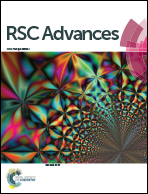Impact of Al doping on a hydrothermally synthesized β-Ga2O3 nanostructure for photocatalysis applications
Abstract
Aluminum (Al)-doped beta-phase gallium oxide (β-Ga2O3) nanostructures with different Al concentrations (0 to 3.2 at%) are synthesized using a hydrothermal method. The single phase of the β-Ga2O3 is maintained without intermediate phases up to Al 3.2 at% doping. As the Al concentration in the β-Ga2O3 nanostructures increases, the optical bandgap of the β-Ga2O3 increases from 4.69 (Al 0%) to 4.8 (Al 3.2%). The physical, chemical, and optical properties of the Al-doped β-Ga2O3 nanostructures are correlated with photocatalytic activity via the degradation of a methylene blue solution under ultraviolet light (254 nm) irradiation. The photocatalytic activity is enhanced by doping a small amount of substitutional Al atoms (0.6 at%) that presumably create shallow level traps in the band gap. These shallow traps retard the recombination process by separating photogenerated electron–hole pairs. On the other hand, once the Al concentration in the Ga2O3 exceeds 0.6 at%, the crystallographic disorder, oxygen vacancy, and grain boundary-related defects increase as the Al concentration increases. These defect-related energy levels are broadly distributed within the bandgap, which act as carrier recombination centers and thereby degrade the photocatalytic activity. The results of this work provide new opportunities for the synthesis of highly effective β-Ga2O3-based photocatalysts that can generate hydrogen gas and remove harmful volatile organic compounds.



 Please wait while we load your content...
Please wait while we load your content...